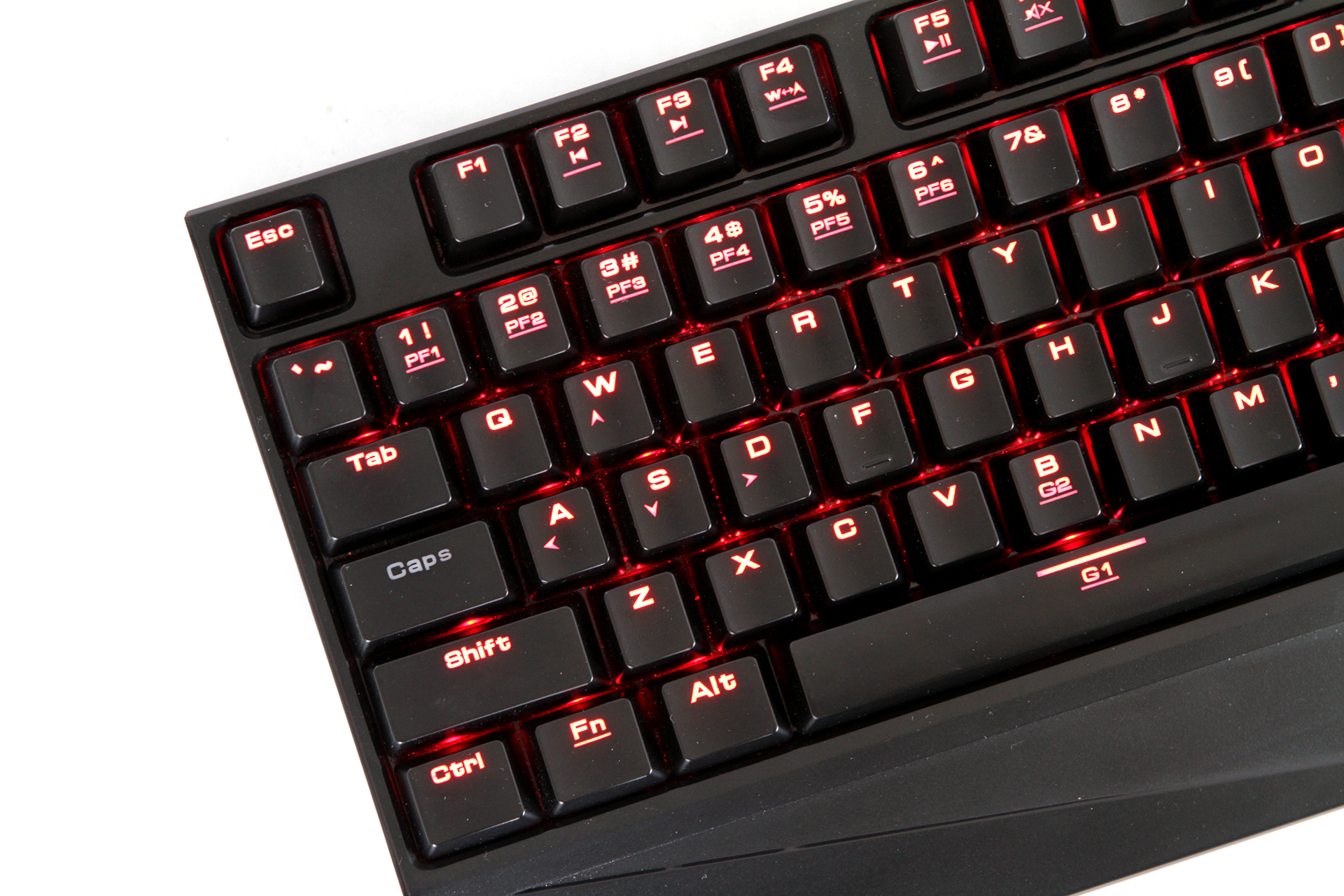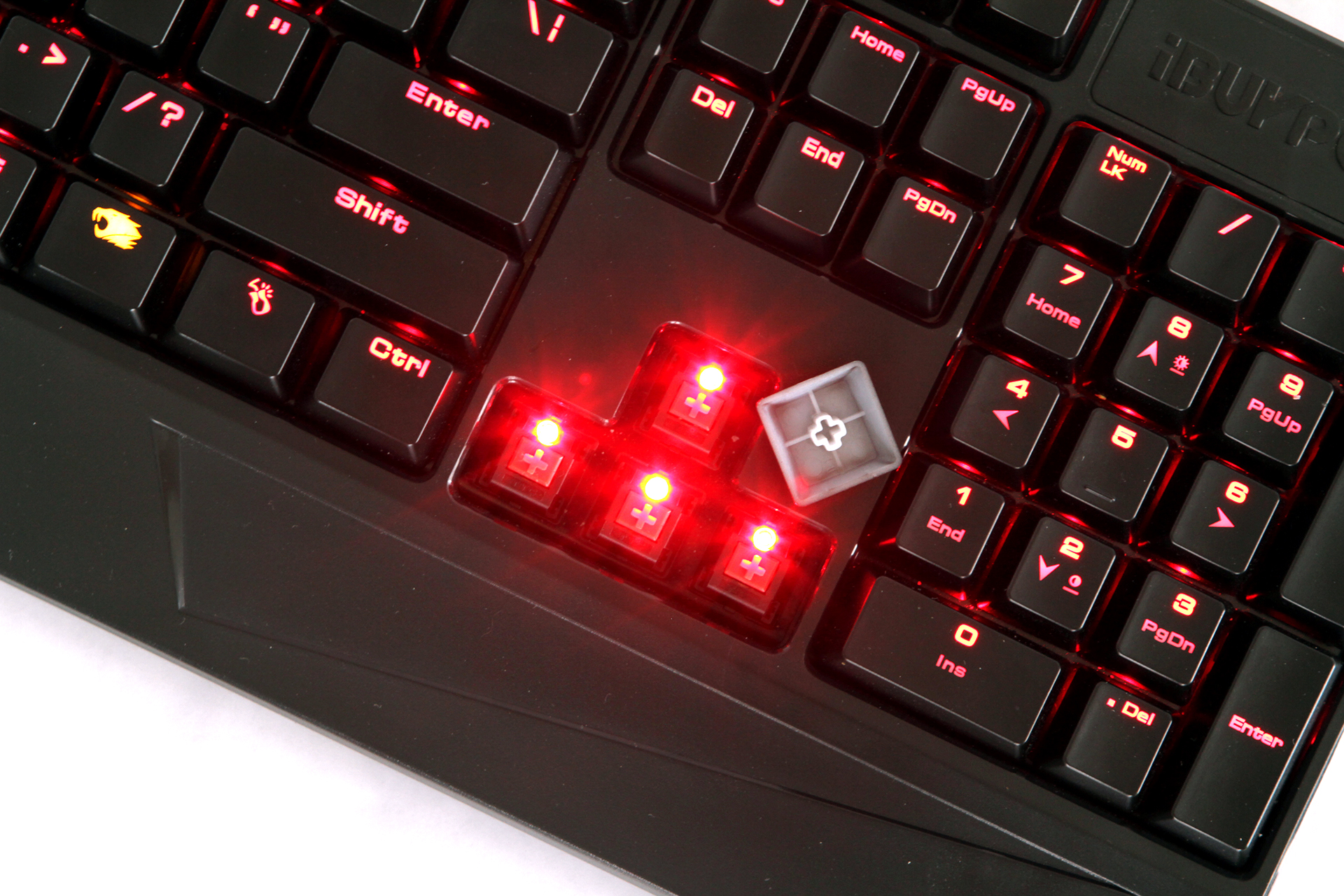iBuyPower MEK Mechanical Keyboard Review
The iBuyPower MEK is actually a rebranded Gamdias Hermes Lite. It comes with TTC Red switches, and the price is right, but this keyboard has some issues.
Why you can trust Tom's Hardware
Product Tour
Although the MEK has an all-plastic ABS chassis, it's about as high quality-looking as plastic can get. The black finish resists fingerprints surprisingly well, and the black plastic keys perfectly match the chassis' color and look.
Gamdias employed a bowl design, wherein a top panel covers the backplate. It's not as slick as the Corsair style of mounting the switches directly to an exposed metal backplate, but Gamdias made the most of it. The top panel is one solid piece of plastic and extends out to give you a built-in wrist rest. (The downside is that if you don't want a wrist rest, you're stuck.)
In the upper right corner of the keyboard is a molded black plastic "iBuyPower" logo that looks a little cheap. One wonders how much it would "pop" if instead that logo was laser-etched and backlit.
There are no additional ports on the MEK, leaving the sides solid. Underneath though, Gamdias built a three-way routing trough for the braided red-and-black cable. Unlike some other keyboard designs that let you route the cable directly out the back or way off to either side, the MEK's three routes are all just a few inches apart. There's one directly in the center of the keyboard, and the other two are just a few inches to the right and left, respectively. This certainly affords you some flexibility for where your USB cable lines up on your desk, but fundamentally I'd prefer that the left and right troughs were closer to the edges of the keyboard. It appears that Gamdias cut the troughs short so they wouldn't run into the flip-up feet, but a better thought-out design would accommodate both, as on the Nixeus Moda V2 and Razer BlackWidow X Chroma. (A minor detail, I allow.)








Key Caps, Switches And Lighting
Like most keyboards, the switches on the MEK are ABS plastic with laser etching, and they're slightly concave. The large, wide font on the keys is not especially elegant, but it certainly contributes to readability.
All of the keys are backlit, and even the secondary characters are illuminated. The color balance under those secondary characters is a little dimmer because the LEDs are positioned at the top of the switches. (You can see this perhaps most prominently on the PrintScreen/SysRq key.) This is despite Gamdias' best efforts—note that the characters are all printed as close to the top of the keys as possible.
Further, the LEDs seem to have rather uneven light spreading. Even in a bright room, you can clearly see points of light peeking out from under the key caps. In a darkened room, it's even more pronounced. I believe that Gamdias attempted to boost the lighting by employing a shiny black metal backplate, which would reflect the light. A top panel design like the MEK uses can sometimes help to reflect light back down onto the backplate. The design choices seem to have backfired.
Get Tom's Hardware's best news and in-depth reviews, straight to your inbox.
One particularly odd choice is that there's a single key that is backlit by a color other than red. The Windows key is emblazoned with an orange-lit iBuyPower logo. Yes, orange. Every key is red except for one clashing orange key. I understand the logic: You want the logo to stand out, and the Windows key is a great place to put it. It's also an important key you want to locate easily with your peripheral vision, but the execution is unfortunate.
On an RGB keyboard, it's a simple remedy to program any offending key to a different color, but the MEK offers only red (er, and orange, I guess, if you count the lone key).
There are just a few lighting effects you can employ. You can choose from three brightness levels (30, 60 and 100 percent), turn the lights off entirely, or set a breathing effect. This is all controllable with key events (Fn+8 on the numpad, Fn+2 on the numpad), or you can do it through the Hera software (more on than it a bit). You can set the breathing cycle to four, six or eight seconds.
A final, and somewhat seizure-inducing, lighting feature is Responsive Lighting. With that box ticked in the software, the lights will kick on only when you type. No matter what you do though, the Print Screen key remains lit.
Gamdias/iBuyPower went with TTC Red switches for the Hermes Lite/MEK—a bold decision, considering the industry perception that anything-but-Cherry is inferior—but I found nothing negative to say about the TTC switches. They're light but springy, and gun to my head, I couldn't tell them apart from Cherry Reds. As you can see in the table below, this is likely because the specifications for the two are strikingly similar, including the required actuation force.
| Header Cell - Column 0 | TTC Red | Cherry MX Red |
|---|---|---|
| Type | Linear | Linear |
| Actuation Point | 1.6 mm (+/-0.4 mm) | 2 mm |
| Total Travel | 4 mm | 4 mm |
| Actuation Force | 45g | 45g |
| Lifespan | 50 million strokes | 50 million strokes |
Current page: Product Tour
Prev Page Introduction And Specifications Next Page Gamdias Hera SoftwareSeth Colaner previously served as News Director at Tom's Hardware. He covered technology news, focusing on keyboards, virtual reality, and wearables.
-
Nintendork Dunno but it sounds noisier than pretty much all of the othes mechanical reds reviewed on this site or in youtube.Reply -
g-unit1111 Mechanical keyboards are just like any other product - you get what you pay for. A $60 mechanical keyboard would be a step up from a $20 membrane keyboard, but there's also the quality factor. I paid $60 for a Cooler Master Storm a few years back and it feels like a $60 keyboard. Whereas I paid $130 for a Corsair K70 and it feels like a $130 keyboard should.Reply -
toddybody ReplyMechanical keyboards are just like any other product - you get what you pay for. A $60 mechanical keyboard would be a step up from a $20 membrane keyboard, but there's also the quality factor. I paid $60 for a Cooler Master Storm a few years back and it feels like a $60 keyboard. Whereas I paid $130 for a Corsair K70 and it feels like a $130 keyboard should.
While I agree with "you get what you pay for" in general, there are some exceptions. The CM Storm Quickfire I bought (~70) is higher quality than the Logitech and Razer Mechs I've demo'd. I think price/quality balance is the most important..some people think 150.00 on a Ducky KB is worth it...others disagree.
-
c_rex Outstanding review. While it was clear that this was not a favorite keyboard, you gave the plusses and minuses that a keyboard shopper would look for. Your opinion was not thinly veiled (which I appreciate). I have one of these keyboards on my desk as I recently purchased a gaming pc from iBuyPower (which rocks) and this keyboard came with it, `but I haven't used it. I have a higher end keyboard with which I am absolutely thrilled and will never likely use the Mek. I wondered how it performed. I will say that having used way too many other keyboards, based on your review I would use the Mek over any membrane keyboard including the Razer Deathstalker Ultimate (which I have). So anyone looking for a budget mechanical should consider the upside on this keyboard as affordable. You might find one on a local ad site or fleabay for less than retail. Anyhow, thanks for this review. It is nice to see reviews for the much less than top of the line gear for budding hardware fanatics to understand all ends of the available spectrum.Reply -
scolaner ReplyMechanical keyboards are just like any other product - you get what you pay for. A $60 mechanical keyboard would be a step up from a $20 membrane keyboard, but there's also the quality factor. I paid $60 for a Cooler Master Storm a few years back and it feels like a $60 keyboard. Whereas I paid $130 for a Corsair K70 and it feels like a $130 keyboard should.
While I agree with "you get what you pay for" in general, there are some exceptions. The CM Storm Quickfire I bought (~70) is higher quality than the Logitech and Razer Mechs I've demo'd. I think price/quality balance is the most important..some people think 150.00 on a Ducky KB is worth it...others disagree.
This is (in part) exactly why we're reviewing keyboards. To me, keyboard pricing in the industry is all over the map. There seems to be little rhyme or reason to it, and therefore I believe that there are probably bargains to be found. And so we rip these suckers apart to see what's under the hood. :)


